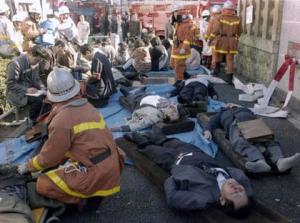European securityMontenegro expels 58 members of Japanese doomsday cult Aum Shinrikyo
Montenegro has expelled fifty-eight foreigners, all members of the Japanese doomsday cult Aum Shinrikyo which, in March 1995, launched a deadly nerve gas attack on Tokyo’s underground. Twelve people were killed and thousands injured in Aum Shinrikyo’s nerve gas attack on a Tokyo commuters.

Emergency personnel attending to victims of 1995 Japanese subway poison gas attack // Source: lafayette.edu
Montenegro has expelled fifty-eight foreigners, all members of the Japanese doomsday cult Aum Shinrikyo which, in March 1995, launched a deadly nerve gas attack on Tokyo’s underground.
Twelve people were killed and thousands injured in Aum Shinrikyo’s nerve gas attack on a Tokyo commuters. AFP news agency quoted a police statement that said they had “received information from partner security services showing that a group of foreign national, who were numbers of a closed religious group, were staying in Montenegro.”
Yahoo News reports that on Friday, security authorities briefly detained the sect members at a hotel in the town of Danilovgrad, and found they did not hold valid visitor permits, so they were ordered to leave the Montenegro.
The country’s interior minister added in a statement that of the 58 foreign nationals, 43 were Russian, four from Japan, seven from Belarus, three from Ukraine, and one from Uzbekistan.
The laptops and mobile phones of the cult members were taken by police for investigation, and each of the groups members was interrogated.
The Council on Foreign Relations notes the religious sect is a cult which combines tenets from Buddhism, Hinduism, and is “obsessed with the apocalypse.”
“At the center of the group’s belief is reverence for Shoko Asahara, Aum’s founder, who says that he is the first ‘enlightened one’ since Buddha,” the CFR adds. He, and thirteen other members of the cult, were sentenced to death in connection with the attack in Japan, and are still awaiting their executions.
A Department of States report adds that subsequent Japanese government investigations revealed the cult was responsible for other “mysterious chemical incidents” in Japan the year before the Tokyo assault — including a sarin gas attack on a neighborhood in Matsumoto which killed seven and hospitalized around 500 residents.
The State Department report adds: “Although Aum has not conducted a terrorist attack since 1995, concerns remain regarding its continued adherence to the violent teachings of founder Asahara that led them to perpetrate the 1995 sarin gas attack.”
